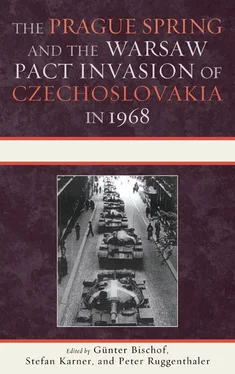In Politburo documents dating from this phase, other, more general common characteristics are to be found. First, all the numerous references were deleted from almost all final versions of resolutions pertaining to “rightists” in Czechoslovakia rallying under the banners of the struggle against the “legacy of the personality cult,” the “dominance of the conservative party nomenclature,” and so forth. Secondly, care was taken not to conjure up facile associations by avoiding in the documents all kinds of comparison of the situation in the ČSSR with the events in Hungary twelve years earlier. On the other hand, in drafts of Politburo resolutions as well as in analyses of the Czechoslovak crisis within the framework of the Warsaw Pact and even in speeches before Soviet audiences (for instance in Brezhnev’s speech in the plenum of the CC CPSU on 17 July), such comparisons were openly made. 27
At the same time, the unmistakable parallels inevitably influenced the Soviet leaders in elaborating and adopting resolutions on Czechoslovakia. Andropov, who had been the Soviet ambassador to Budapest in 1956 and had witnessed the Hungarian Revolution on the spot, said as late as March 1968 that “the methods and forms that were being applied in Czechoslovakia, were strongly reminiscent of the Hungarian ones…. In Hungary things also started to get moving in this way.” 28In addition to broad similarities in terms of the general situation (economic problems, a precipitous decline in the authority of the Communist Party, demands for changes in the political system, the revitalization of diverse political clubs and civic associations, strongly marked anti-Soviet and anticommunist tendencies in the mass media), there were less obvious correspondences, which might have escaped an outside observer, but did not go unnoticed in the Kremlin. Just as in the summer of 1956, when Moscow was driven by the fear “to betray its principles and show weakness” and did everything in its power to keep the Stalinist Mátyás Rákosi in power, so now the USSR was just as desperate (and equally unsuccessful!) in keeping Novotný at least in the post of the Czechoslovak president. In 1956, the future Hungarian Communist Party leader János Kádár rose in the eyes of the Kremlin within a few months from a “right-wing opportunist” to a “dedicated Marxist-Leninist”; in Czechoslovakia twelve years later, Gustáv Husák, who had been classified as “politically suspect” only a short while, before quickly accumulated bonus points in the assessment of the Soviet leaders, who were casting around for an acceptable candidate to replace Dubček. Another similarity, if a coincidental one, is the fact that in both cases Poland played a role in the initial stages. 29There was one more detail which was deeply embarrassing for the USSR under the existing circumstances, namely the tenth anniversary of the execution in the summer of 1958 of Imre Nagy—his face one of the emblems of the Hungarian Revolution. The Czechoslovak “free press” commemorated this event with an openly anticommunist article, which caused great indignation in Moscow. An explanation was immediately supplied by Dubček. 30
There were, however, also basic differences between events in Hungary and in Czechoslovakia. This is particularly noticeable in the attitudes of the leading Soviet figures, most of whom were working hard to avoid a solution that involved the use of force. Moscow realized that however much cause the USSR might have to complain to the world about the intrigues of imperialism and Western plots against Socialist Czechoslovakia, “reestablishing order” in the Eastern Bloc through the use of military means was only going to give the world at large one more reason to doubt the viability and the progressive character of socialism. This is presumably why the military maneuver of the Warsaw Pact countries, which were conducted on Czechoslovak territory in June 1968, did not escalate into a military intervention, despite the fears (or conversely, the expectations) harbored by many. Not even the delay in the evacuation from Czechoslovakia of the Soviet troops after the maneuver, which was immediately branded as “massive meddling in the internal affairs of the ČSSR” by the country’s press, was directly related to the invasion, the preparations for which had already been completed. 31
By the standards of the Hungarian revolutionaries, the Czechoslovak reformers proceeded with extreme caution and circumspection, for the simple reason that they, too, feared a replay of the events in Hungary. They also had many more possibilities for maneuvering and for accomplishing the tasks they had set themselves one by one. In Hungary, Rákosi was succeeded by András Hegedu“s (who actually pursued the same course as his predecessor), and the reformer Nagy did not take over as head of state until the revolution was already underway. By contrast, Dubček assumed power in Czechoslovakia straightaway; there were no intermediaries, even though candidates for the part might have been found among Novotný’s supporters, such as Josef Lenárt, Bohumír Lomski, or other top functionaries.
Yet it was precisely this evolutionary development of events which seemed most ominous to the Soviet nomenclature and almost automatically spurred them into decisive action. Fear was rife in the USSR that one might fail to notice—and preempt—that moment when Czechoslovakia would metamorphose into a bourgeois, democratic country with all the baleful consequences for the Socialist camp. There was, of course, the additional prospect that a restoration of the capitalist system was not going to be accomplished without bloodshed; in Moscow, there was even talk of the danger of a civil war in Czechoslovakia. Whatever the scenario, it was reasonable to assume that military intervention under the rapidly changing circumstances would take a great toll, both in human lives and in political and economic terms. The fear of “delaying the re-establishment of order” until it was too late, on the one hand, and the blatant difference between the bloody uprising of the people in Budapest in October 1956 and peaceful Prague in July 1968, on the other, created a situation that made it extremely difficult for Moscow to explain even to its most stalwart supporters its reasons for what looked from outside like a totally inadequate reaction to the developments in the ČSSR.
To an extent, Dubček himself also contributed to the invasion in that his constant promises of an imminent improvement in the situation (which never materialized) caused the number of Soviet leaders who advocated the use of force to solve the problem to grow. Dubček even gave specific dates. First the promise was made that sweeping changes for the better would occur after the “April plenum” of the CC KSČ, which was going to give the green light to the Czechoslovak Communist Party’s “Action Program.” In Moscow, some felt the “program” had several flaws, yet given the circumstances, it was not reasonable to expect that anything better could be cobbled together. This “program” was never realized. At the end of May, Dubček gave a new pledge to Kosygin that the forthcoming plenum was going to make all the difference. The resolutions that were going to be adopted by it would bring about a drastically altered situation and enable the KSČ leader at long last to take an “offensive line.” 32The plenum came, the plenum went, and things continued the same as before. The same scenario was played out again at the next plenum, on which Dubček had also pinned the hope that it was going to make a change. It was, therefore, no coincidence that there was no one left in Moscow who still gave credence to the assurances of the Czechoslovak party leader that the forthcoming 14th Party Conference of the KSČ was going to bring the “breakthrough.” To be precise, it was the other way round. A commonly held belief in the USSR was that this party conference would prove “decisive,” but not in the sense Dubček meant. The belief had taken hold that this party forum was going to yield the result that the Czechoslovak party leader and his supporters were ousted from power, that the KSČ would end up demoralized and in a shambles for good, and that power would be seized by “reactionary” forces. It was a deeply apprehensive Brezhnev who voiced these concerns and who remarked that “a way out of the present impasse could also be the elimination of all the present members of the Presidium of the CC KSČ from the party leadership.” 33
Читать дальше












